Fact Sheet FS1121
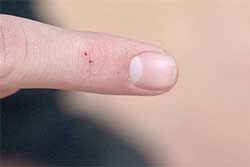
Figure 1: Spider bite.
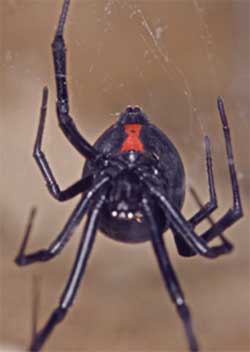
Figure 2: Southern black widow spider.
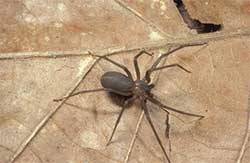
Figure 3: Brown recluse spider.
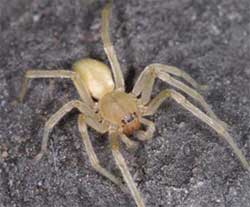
Figure 4: Yellow sac spider.
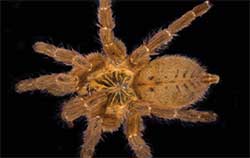
Figure 5: Orange baboon trantula.
Among the 38,000 known spider species in the world, about 100 species have venom that is detrimental to humans. In North America, only the widow spiders in the genus Latrodectus and the recluse spiders, in the genus Loxosceles are dangerous to humans. Spiders, including widow spiders and recluse spiders, are generally timid creatures. In fact, spiders seldom bite people. Spider bites (Figure 1) usually result from spiders being accidentally trapped against the skin or being handled. This publication describes the two medically important spider groups, the group that causes the most spider bites in the United States, and pet spiders.
Widow spiders (Latrodectus spp.)
Widow spiders get their common name from the belief that the female eats the male after mating, which rarely happens in nature. They occur in every state in the United States. Five Latrodectus species occur in North America. The southern black widow (Latrodectus mactans) is the most notorious because of its potent venom, widespread occurrence, and likely contact with humans and domestic animals. It is found throughout North America, from southern New England to eastern Mexico. The southern black widow spider is recognized by its black color and red triangular marks that often form an hourglass-shaped marking on the underside of the abdomen (Figure 2). Young spiders (spiderlings) are primarily orange and white but become darker as they molt. Mature females are nearly ½ inch (13 mm) in body length, and males are about half that size.
Black widow spiders live under stones, in firewood piles, under decks, in hollow stumps and trees, and in rodent burrows. Indoors, they are found in garages, basements, and crawl spaces. In the spring, female black widow spiders deposit eggs in silken egg sacs. A female may produce up to 21 egg sacs, each with a few hundred eggs. After an 8–30 days incubation period, spiderlings emerge from eggs. The spiderlings molt 4–9 times and become adults the next spring. Black widow spiders build irregular webs in dark, hidden places.
Black widow spiders produce venom that contains a neurotoxin. Their bite causes pain radiating from the site of the bite. In severe cases, nausea, overall aching of the body, sweating, and labored breathing may occur. Symptoms will disappear after several hours to several days.
Recluse spiders (Loxosceles spp.)
Recluse spiders (genus Loxosceles) are notorious for their potent venom. Thirteen species are known to occur in the Unites States. Most Loxosceles are restricted to the southwest, from southern California to southern Texas. The brown recluse, Loxosceles rufescens, was introduced from Europe and is now established over much of the southern USA, and recently in New York (Figure 3). It is the most important and widespread recluse spider. Recluse spiders are yellowish to grayish brown. Most species possess the dark brown violin marking on the dorsal cephalothorax (head united with thorax). Mature brown recluse spiders are 7 to 12 mm in body length but may look much larger because of their large legs.
Recluse spiders occur in a variety of habitats. They hide in crevices that they line with silk. Indoors, they may be found in boxes, shelves, corners, under furniture, or other undisturbed areas. After mating, the female spider lays 20–50 eggs in off-white round silken cases. One to five egg sacs are produced during the female's lifetime. Adults commonly live up to 2.5 years.
Brown recluse spiders posses a cytotoxin. Their bite may produce an immediate stinging sensation followed by intense pain. A small blister usually appears, and the surrounding bite area becomes swollen. Victims sometimes experience restlessness, fever, and difficulty in sleeping. The killed tissue leaves an open ulcer. Confirmed injury and death are rare. Staphylococcus or Streptococcus bacterial infections, lymphoma, tick bites, and herpes viruses may be misidentified as brown recluse spider bites.
Yellow sac spiders (Cheiracanthium spp.)
Yellow sac spiders derive their name from their yellow color and the silk tube or sac they construct to hide in during the day. They are typically less than 3/8 inch (10 mm) in length. Only two Cheiracanthium species occur in North America: Cheiracanthium inclusum (Figure 4), and Cheiracanthium mildei.
Yellow sac spiders are more common outdoors than indoors. Female spiders lay eggs in June and July in a loose mass. The spiderlings overwinter and become adults next May to June. They enter structures through faulty screens, loose fitting, unsealed doors, vents, utility lines, and plant materials brought inside. Inside structures, yellow sac spiders build silken retreats at upper corners of ceiling wall junctions, and in basements and crawl spaces. Outside, yellow sac spiders are found beneath loose bark, in leaf litter, and under rocks. They can also be found behind shutters, under eaves, and at corners of windows.
Yellow sac spiders are believed to cause more spider bites than any other spider in the United States. Their bites rarely result in more than localized redness and burning sensation at the site of bite. The symptom lasts for hours to a maximum two days.
Pet Spiders
Tarantulas (Family: Theraphosidae) are often kept as pets. Tarantulas are 9–75 mm in size and typically light brown to black (Figure 5). The abdomen is generally clothed with blackish colored pubescence and longer orange-buff hairs (setae). They are found in North America, South America, Europe, Africa, Australia, and southern Asia. The greatest numbers are found in South America.
In the wild, tarantulas are typically ground-dwellers living in silk-lined burrows. They are nocturnal sit-and-wait predators and are rarely found more than a few centimeters away from their burrow entrances. Most tarantulas are not very toxic. Bite reactions vary from painless to moderately or intensely painful, with reddening about the puncture site. The pain seldom persists for more than 30 minutes. Some tarantulas in Latin America, Africa, and Asia contain neurotoxins in their venom. The venom can cause severe, sometimes life-threatening reactions.
Many tarantulas possess tiny hairs on their abdomen, which are readily detached when stroked with their hind legs. The hairs cause irritation to the skin and inflammation of the eyes, mouth, and respiratory passages. Rubbing the affected areas will worsen the symptoms. People who are allergic to bee stings or spider hairs should avoid handling tarantulas. Pet tarantulas vary in their aggressiveness. People should be familiarized with their behavior before buying and handling tarantulas. A useful guide about tarantulas can be found at: tarantulaguide.com.
Prevention and Control
Prevention consists of changing the lighting to off-building locations so insects are not attracted to the building, sealing all entry points to the building, cleaning out clutter, removing debris, and trimming back vegetation adjacent to structure. When working outdoors, it is helpful to wear long-sleeved shirts, long trousers, and gloves. Keeping the house clean and regularly removing spider webs with a broom will minimize the presence of spiders. Inspect clothing, towels, and shoes before they come into contact with your body.
Control methods include physical removal with a vacuum machine or broom. The vacuum bag should be removed and sealed immediately after vacuuming. Spray pesticides directly on the spider for a quick kill before removing the web. In addition, insecticide dust or spray can be applied to the harborages and the web.
What to Do If Bitten by Spiders?
Spider bites usually only cause a little pain, swelling, and redness. It is only necessary to seek medical help when sweating, swelling of nearby lymph nodes, or other signs that have gone beyond the bite site occur. Whenever a person is bitten by a spider, it is critical to collect the spider and send away for positive identification by an expert. Just having spiders at home is not a valid justification for blaming spiders for unusual wounds or sores. Many other arthropod bites cause similar bite symptoms as spiders. Examples are: mites, mosquitoes, ticks, and bed bugs. It is common that people attribute unknown bites to spiders.
In the event that a person is bitten by a poisonous spider, application of alcohol or hydrogen peroxide to cleanse the bite area immediately after bitten is helpful. There is an antivenom for widow spider venom. If treated, bites are rarely fatal except occasionally in small children. Immediately call a physician, or go to an emergency room if bitten by widow spiders.
References
Photo credits: David O'Connor (Figure 1); David Cappaert, Michigan State University, Bugwood.org (Figure 2); Sturgis McKeever, Georgia Southern University, Bugwood.org (Figure 3); Joseph Berger, Bugwood.org (Figure 4); David Cappaert, Michigan State University, Bugwood.org (Figure 5).
May 2010
Copyright © 2024 Rutgers, The State University of New Jersey. All rights reserved.
For more information: njaes.rutgers.edu.
Cooperating Agencies: Rutgers, The State University of New Jersey, U.S. Department of Agriculture, and Boards of County Commissioners. Rutgers Cooperative Extension, a unit of the Rutgers New Jersey Agricultural Experiment Station, is an equal opportunity program provider and employer.

